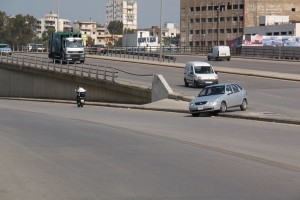In this tiny country, forever caught in a cycle of construction, destruction and reconstruction, the landscape changes fast, and Zawarib Beirut is determined to keep up. Only five years old, the first edition of this road map of Greater Beirut had already been left behind by developments in the infrastructure. This brave venture by Bahi Ghubril, who undertook the gargantuan task of mapping out the city as a personal project, has now been propelled to the next stage.
You may have noticed that, in general, the Lebanese don’t do maps any more than they do addresses. This is a country where your takeaway receipt comes with a paragraph-long description of where you live for the delivery boy. Even City Mall did without a store plan until last summer. One can only hope that an architect’s plan existed prior to construction.
But what makes Zawarib a chef d’oeuvre is that, like Lebanese spatial perception, it is based on landmarks, both official and unofficial. The 2010 edition builds on this, with even more stores, pharmacies and buildings labelled. A large number of them are indexed. So you don’t need to know what street you are on (how could you?) to find the relevant page in the atlas. In fact the index comes in three colours for street names, points of reference and area names.
The new edition is not only updated; it also covers a much greater area. Previously portraying the metropolis from the airport to Naccache, the atlas now begins with Khaldeh and Aley in the south and follows the coastal sprawl all the way north to the Bay of Jounieh. This extension prompted a change in subtitle from Greater Beirut Atlas to Beirut and Beyond. The latest edition also includes some random trivia in the margins and there’s an index of useful places (hotels, universities, parks and more) with map coordinates and telephone numbers.
One of the strengths of Zawarib is that it crystallises facts that may be accepted, contested or ignored but for which the most authoritative reference thus far has been general opinion. Ghubril’s tour de force is the bus map. There were those who said it didn’t exist and those who said it couldn’t be found. But here it is. Admittedly, the routes are not listed in order. It starts with line 7 and ends with 4. And there are only 12 routes, of which two are labelled 15 (one red, one grey). They are like a bunch of unruly kids told to stand at the front of the class – writing their names on the blackboard won’t actually make them behave. But this is a trifling matter which will not distract us from the wondrous discovery of a portable, legible bus map (yep, I’ve tried LCC’s website too).
The new edition also sets down in black and white the direction of one-way streets. This is particularly useful for the grid of backstreets in Hamra, where instead of sensibly alternating directions, each side-street seems to change direction at every crossroads. Of course we cannot expect a wholesale conversion of Lebanese drivers to obeying such trivial rules. But uni-directional traffic cannot always be ignored.
Take, for example, the seaside highway, parallel to the motorway north of Beirut, which is one way part of the day and the other way the rest of the time. Or maybe it’s the other way round. At some point it suddenly does an about turn and changes direction. How do you know if it’s going your way? You just have to go and find out. No sign, no written schedule. If the majority of cars are going north, then you have to go north that time. A few hours later you will be able to turn round and go south again. Now for the first time the general public have access to a timetable for the road; you’ll just have to buy Zawarib to find out.
All in all a great buy, but one which mustn’t entirely replace asking for directions. Even if you know where you are going, still ask a few people – it is the only way you can find out how to tell other Lebanese where you’ve been.
Zawarib Beirut and Beyond, Bahu Ghubril
LL 18,000 Publisher: Zawarib SARL

Nice find! At the expense of sounding like a total geek (which I kinda am), do you know if there’s an online/app version ?
We are currently working on a mobile version and should be released soon. To stay updated with Zawarib join our fan page http://www.facebook.com/zawarib
Follow us on twitter http://www.twitter.com/zawaribworld
Subscribe to our youtube channel http://www.youtube.com/zawaribworld
The Zawarib Team
Thanks for this answer, will look forward to it.
great with zawarib! fyi, the seaside highway is open towards Beirut in the mornings (until 10 or 11) and then again late afternoon. This is to make traffic more flowy for people living north and who need to work in Beirut. A bit confusing i know, but it helps!
Hey, anything that eases the traffic jams – hard to believe that it could be even worse. Maybe they’ll eventually rebuild the coastal railway.
[...] This post was mentioned on Twitter by zawaribworld, j.. j. said: "Like Lebanese spatial perception, @ZawaribWorld is based on landmarks, both official and unofficial" http://bit.ly/e3G0nE #beirut #lebanon [...]